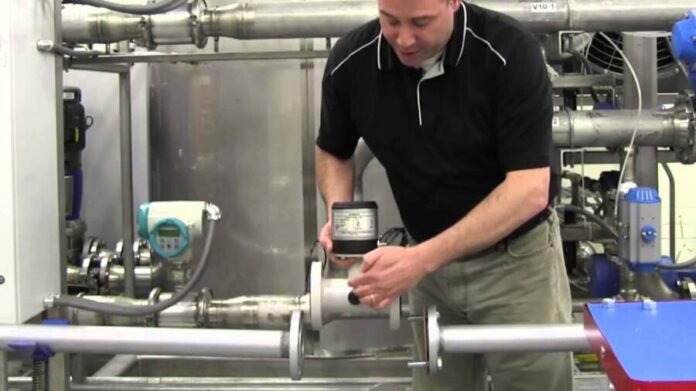Are you installing a flow meter? Avoid common mistakes by following these tips.
- Choose the right flow meter for your needs.
- Place and mount it correctly.
- Ensure sufficient straight run of pipe.
- Establish proper grounding and electrical connections.
Don’t forget to calibrate and maintain the flow meter regularly to ensure accurate readings.
By avoiding these errors, you can achieve reliable and accurate flow measurements.
Common Flow Meter Installation Mistakes and How to Avoid Them
1) Incorrect Flow Meter Selection
You should avoid selecting the wrong flow meter for your installation. Choosing the correct flow meter is crucial for accurate measurement and efficient operation.
When selecting a flow meter, you need to consider several factors, such as the type of fluid, flow rate, pressure, temperature, and the desired accuracy.
Selecting the right flow meter can lead to accurate readings, poor performance, and increased maintenance costs. For example, using a volumetric flow meter for a gas application can result in incorrect measurements due to the compressibility of gases. Similarly, using a flow meter with a low pressure rating for a high-pressure application can lead to damage and leaks.
To avoid these issues, thoroughly analyze your installation requirements and consult with experts to ensure you choose the right flow meter for your specific application. Learn more here: https://www.smartmeasurement.com/magnetic-flow-meters/
2) Improper Placement and Mounting:
Place and mount the flow meter correctly to prevent errors. Improper placement and mounting can lead to accurate measurements and reliable data.
When positioning the flow meter, avoid placing it near any obstructions or bends in the pipe that could cause flow disturbances. Ensure that the flow meter is installed in a straight section of pipe, with enough distance both upstream and downstream to allow for proper flow profile development.
Additionally, make sure the flow meter is mounted securely to prevent any vibrations or movement that could affect its performance. Use the correct mounting hardware and follow the manufacturer’s guidelines for installation.
Taking the time to place and mount the flow meter properly will ensure accurate and reliable flow measurements.
3) Inadequate Pipe Straight Run
When installing the flow meter, ensure a sufficient amount of straight run pipe both upstream and downstream to allow for proper flow profile development. This is crucial for accurate measurement. Without enough straight pipe, the flow profile can be distorted, leading to inaccurate readings.
The straight run pipe helps to stabilize the flow, reducing turbulence and swirl that can affect measurement accuracy. A general rule of thumb is to have at least 10 times the pipe diameter of straight run pipe upstream and 5 times the downstream pipe diameter. However, the exact requirements may vary depending on the type of flow meter and the specific application.
It’s important to consult the manufacturer’s guidelines and recommendations for proper installation to ensure accurate and reliable flow measurement.
4) Poor Grounding and Electrical Connections
Ensure proper grounding and secure electrical connections to prevent potential issues with inaccurate flow measurements.
When installing a flow meter, paying attention to the grounding and electrical connections is crucial. Neglecting this step can lead to unreliable flow measurements and costly errors in your operations.
To ensure proper grounding, make sure that the flow meter is connected to a stable and reliable ground point. This will help minimize the effects of electrical noise and interference, resulting in more accurate measurements.
Additionally, secure electrical connections are vital to maintain a consistent flow of electrical signals between the flow meter and the control system. Loose or faulty connections can cause signal loss or fluctuations, leading to inaccurate flow readings.
Take the time to double-check all electrical connections and ensure they’re tight and secure for reliable flow measurement.
5) Failure to Calibrate and Maintain Regularly
If you neglect regular calibration and maintenance, you risk inaccurate flow measurements and potential errors to your operations.
It’s essential to understand the importance of calibrating and maintaining your flow meter regularly. Doing so ensures that your measurements are accurate and reliable, enabling you to make informed decisions in your operations.
Regular calibration helps to correct any drift or inaccuracies that may occur over time, ensuring that your flow meter remains precise.
Additionally, proper maintenance ensures that your flow meter functions optimally, preventing any potential issues or breakdowns that could disrupt your operations.
Frequently Asked Questions:
Can a Flow Meter Be Installed in Any Orientation?
Yes, a flow meter can be installed in any orientation.
However, it’s important to consider factors such as the flow direction, accessibility for maintenance, and the manufacturer’s recommendations for optimal performance and accuracy.
How Do I Determine the Appropriate Flow Meter Size for My Application?
To determine the appropriate flow meter size for your application, consider factors like the flow rate, viscosity, and pipe size.
Consulting the manufacturer’s guidelines or seeking professional advice can help you make the right choice.
What Are the Consequences of Not Maintaining Regular Calibration for a Flow Meter?
You risk inaccurate measurements if you don’t maintain regular calibration for a flow meter. This can lead to costly errors, decreased efficiency, and potential safety hazards.
Stay on top of calibration to avoid these consequences.
What Are the Potential Risks of Not Properly Grounding and Making Electrical Connections for a Flow Meter?
Not properly grounding and making electrical connections for a flow meter can pose potential risks.
Avoiding these mistakes is crucial to ensure accurate readings and prevent electrical hazards.
Wrap Up: Common Flow Meter Installation Mistakes
So, if you want to avoid common flow meter installation mistakes, remember to:
- Carefully select the right flow meter for your needs
- Ensure proper placement and mounting
- Provide adequate pipe straight run
- Establish good grounding and electrical connections
- Regularly calibrate and maintain your flow meter.
By taking these steps, you can ensure accurate and reliable flow measurements, saving time, money, and headaches in the long run.
Must Read: Benefits Of Hiring A Commercial Locksmith





























































